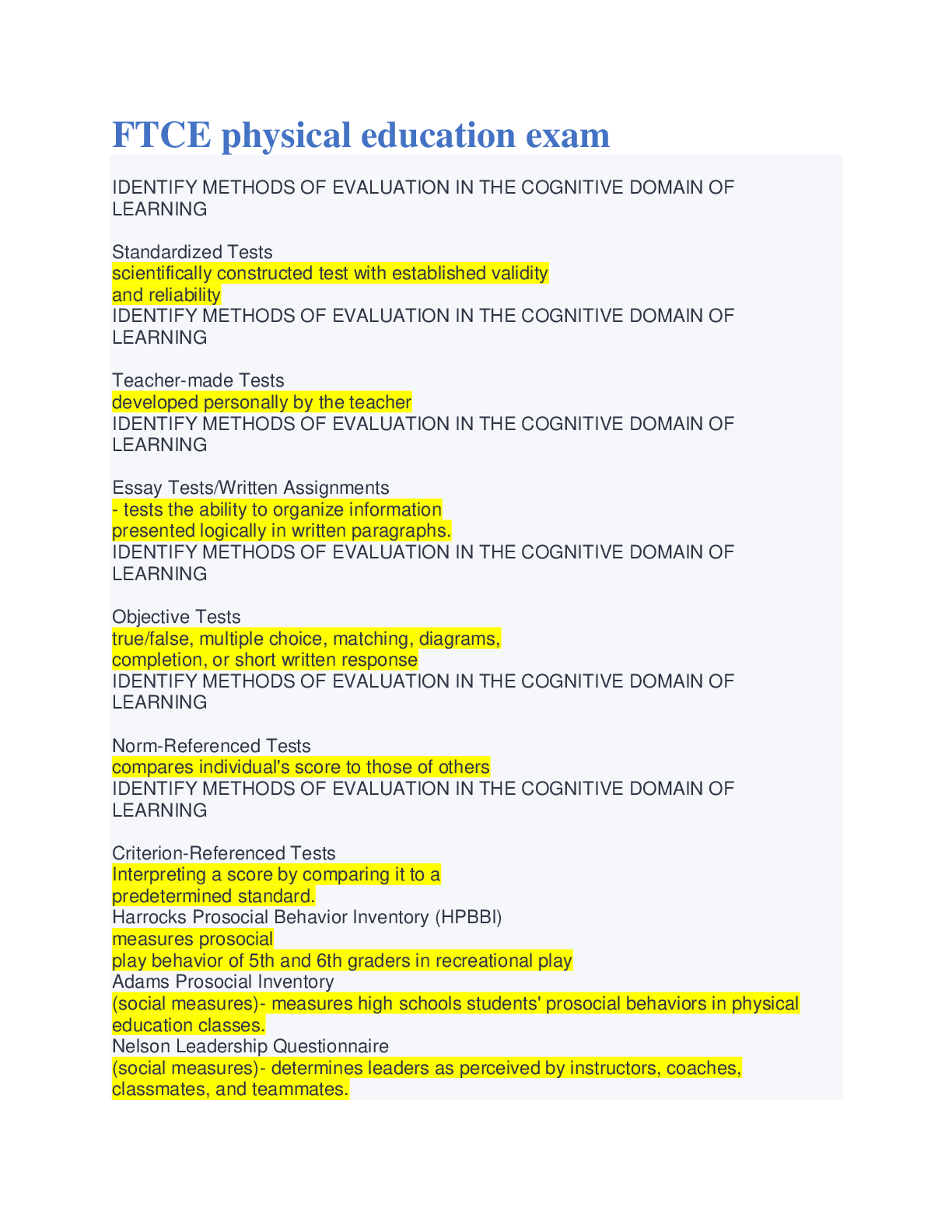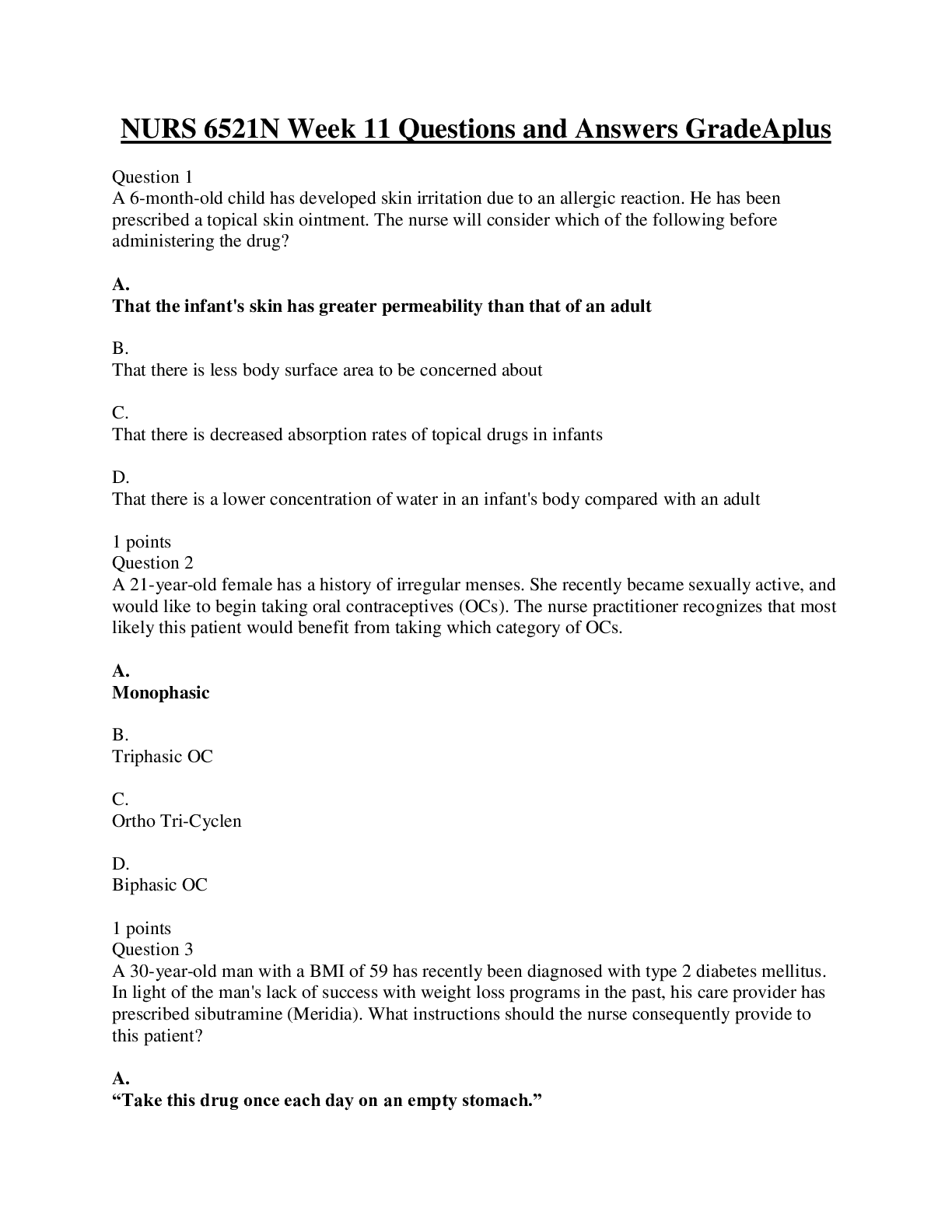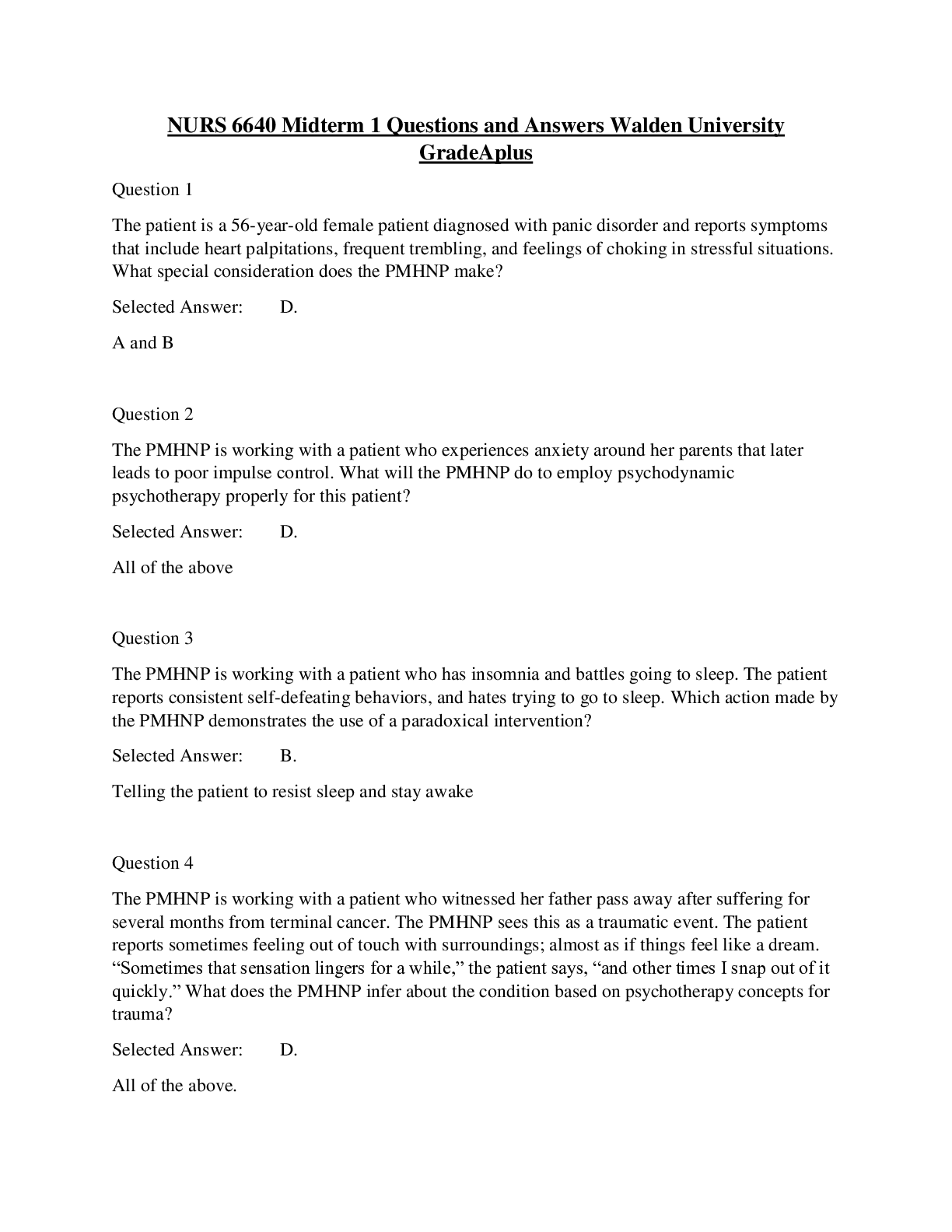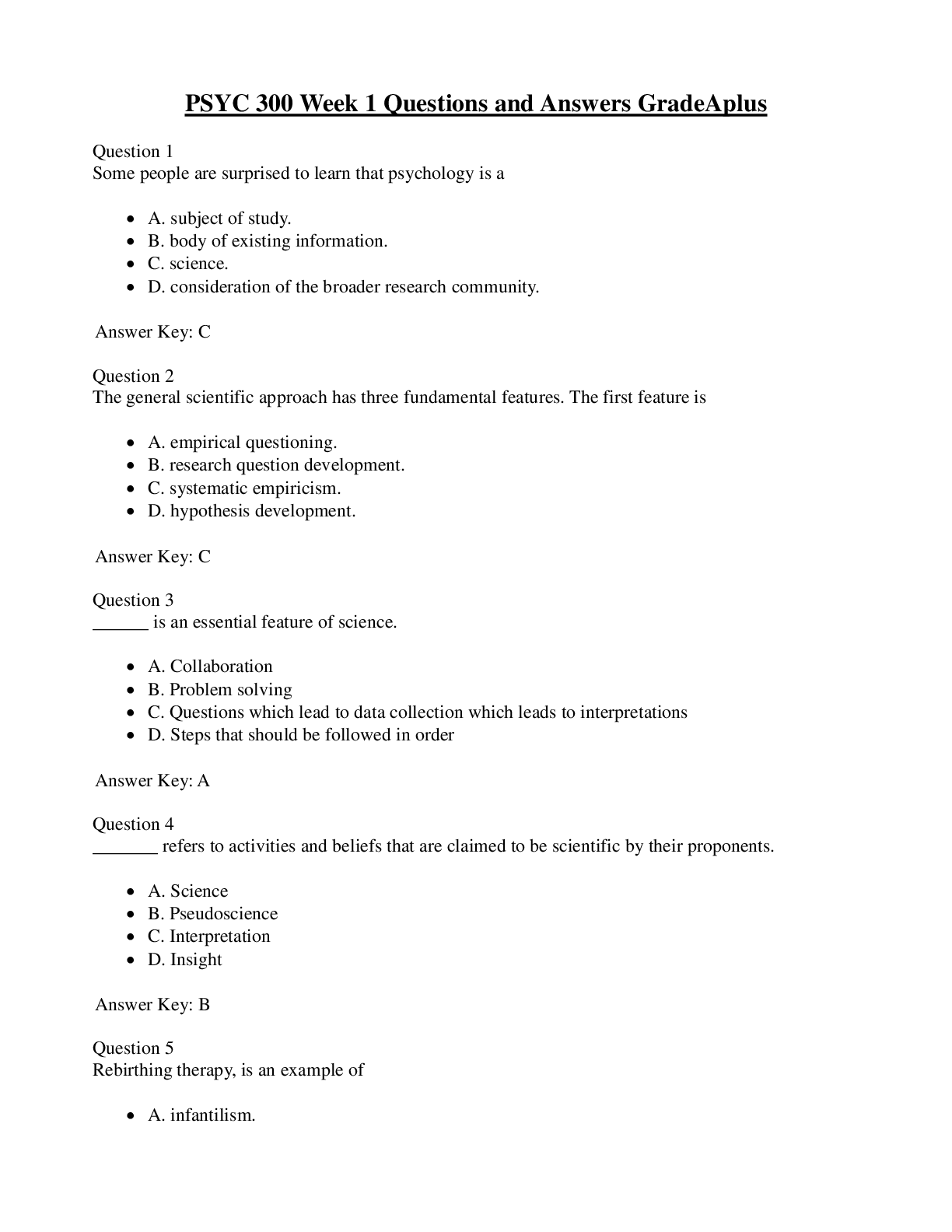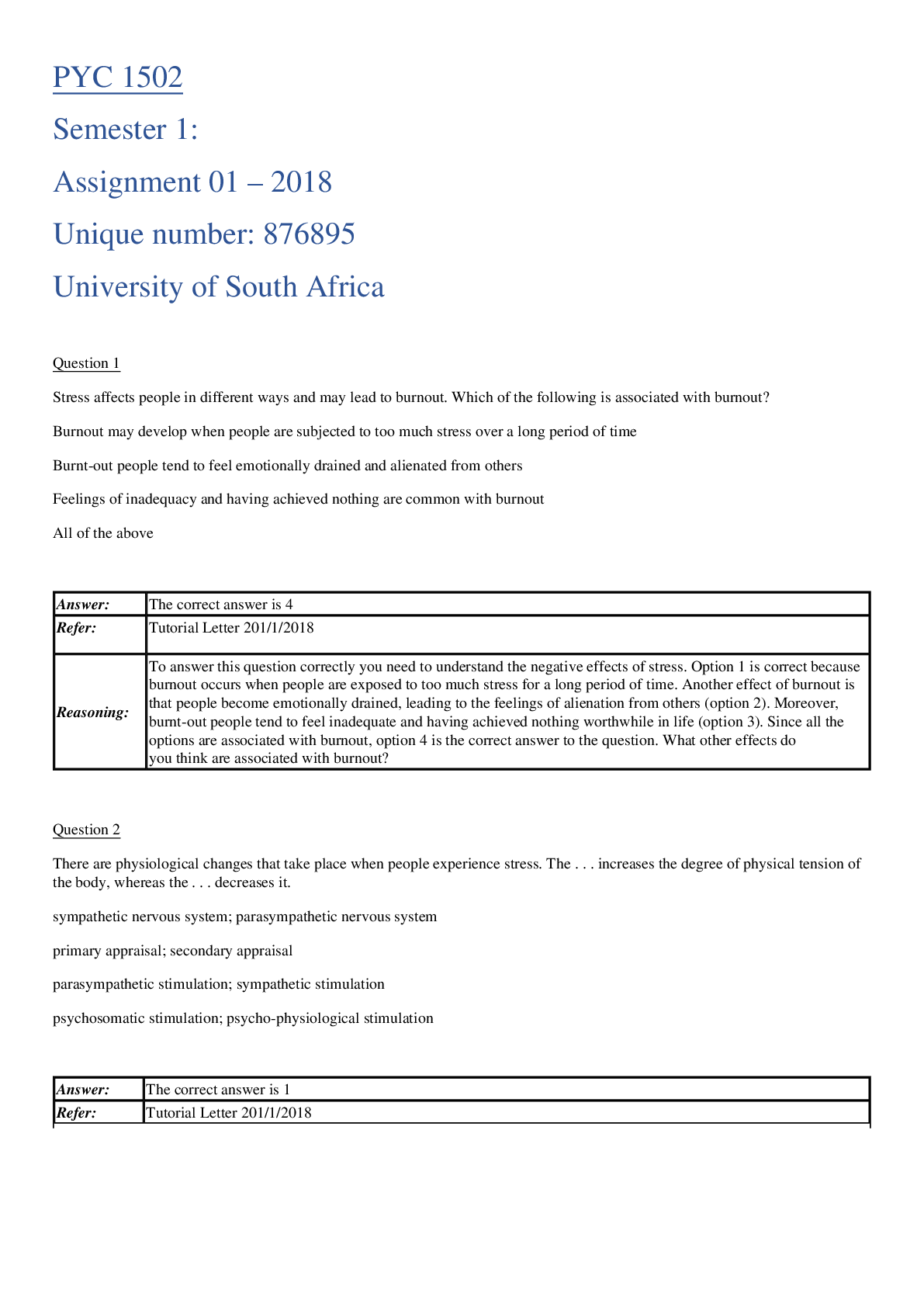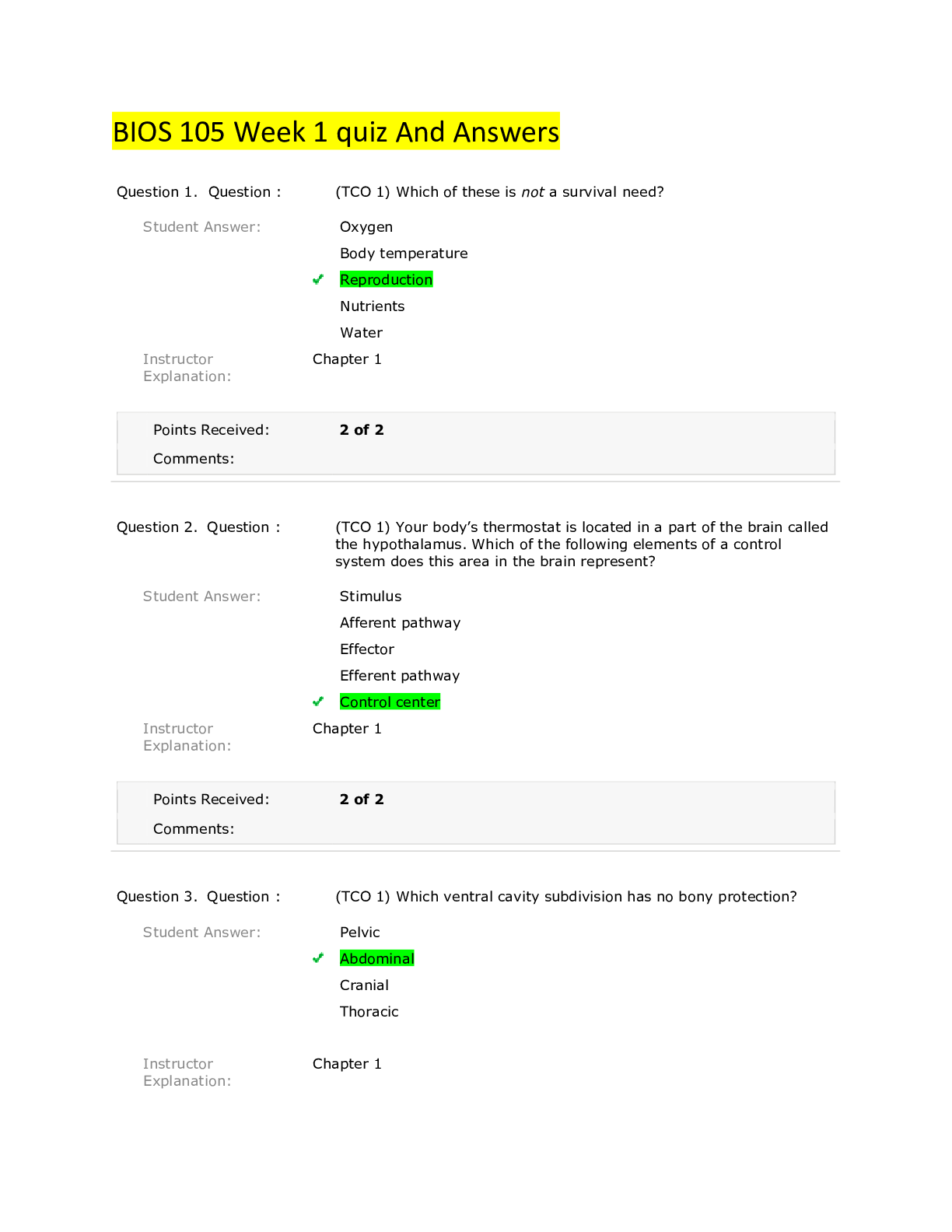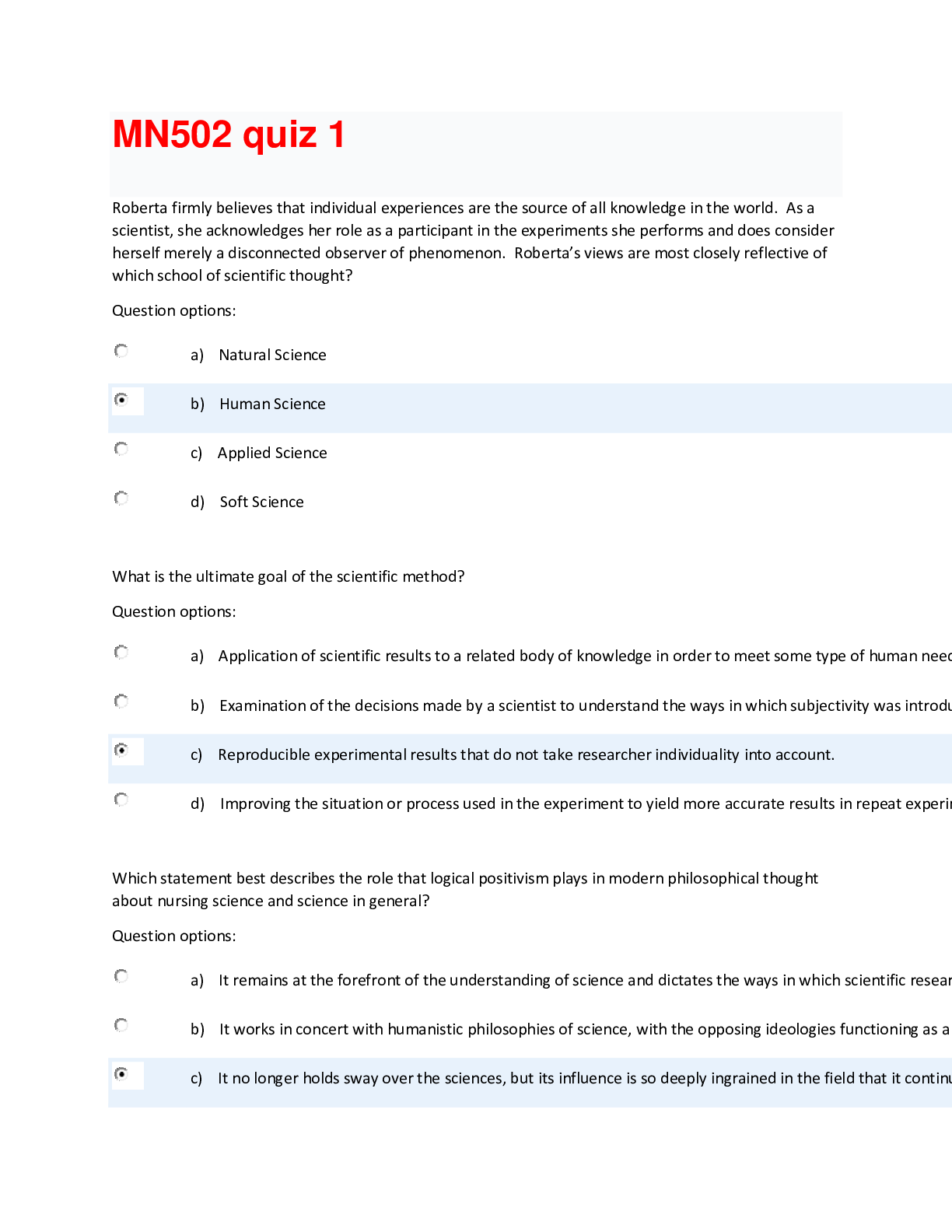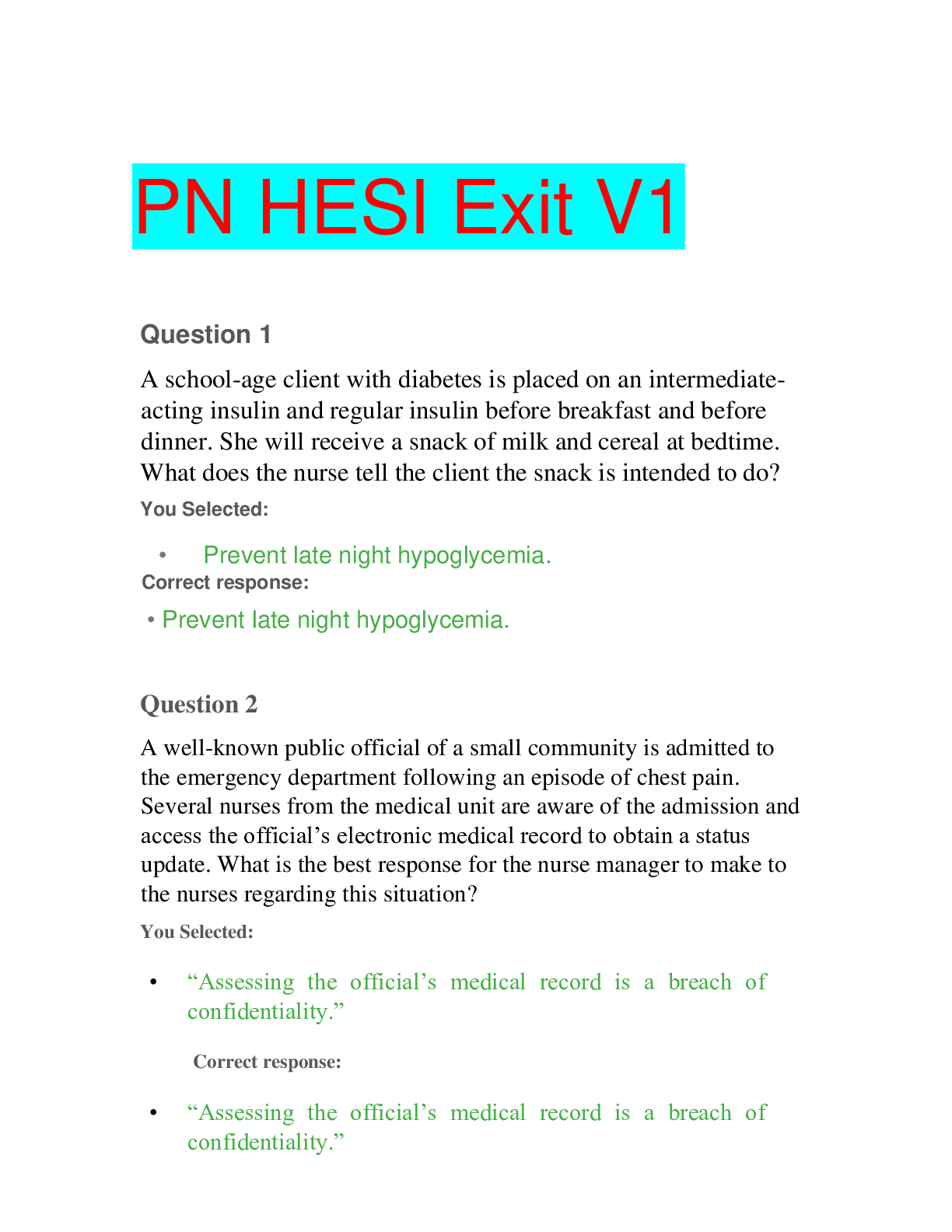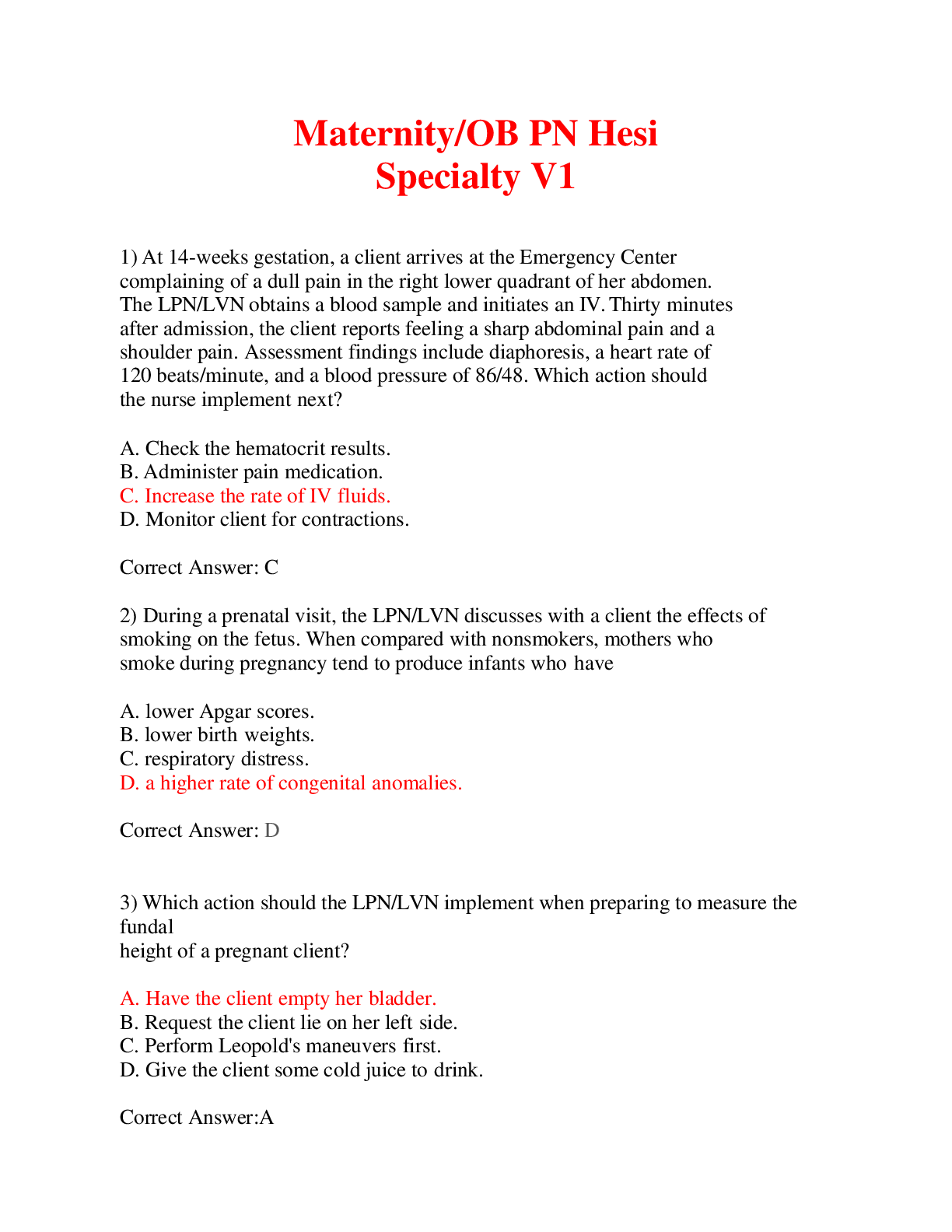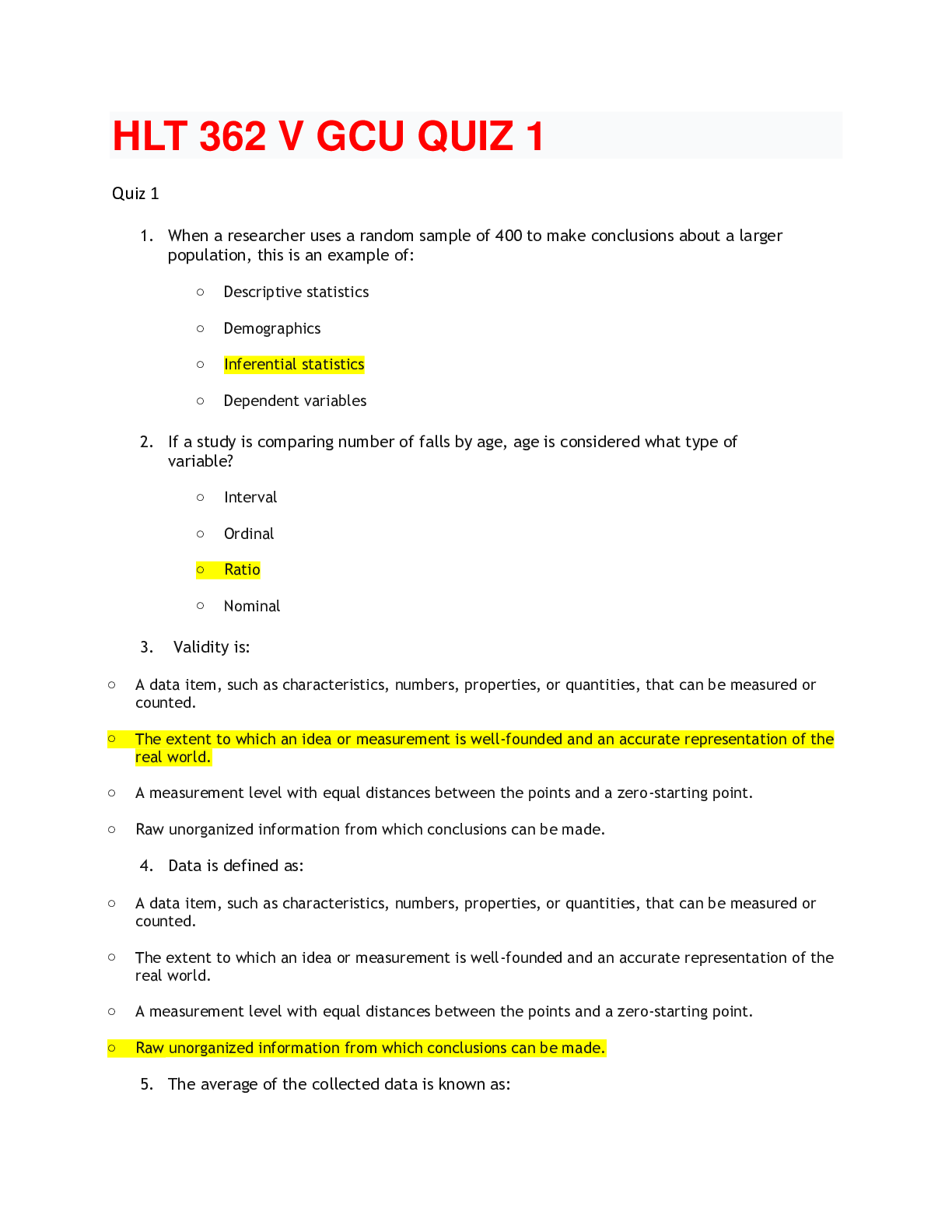Health Care > EXAM > HEALTH ASSESSMENT 1 QUESTIONS AND ANSWERS A GRADED (All)
HEALTH ASSESSMENT 1 QUESTIONS AND ANSWERS A GRADED
Document Content and Description Below
A client comes to the health care provider's office for a visit. The client has been seen in this office on occasion for the past 5 years and arrives today complaining of a fever and sore throat. Whic... h type of assessment would the nurse most likely perform? Comprehensive assessment Ongoing assessment Focused assessment Emergency assessment Focused assessment A client has just been admitted to the postsurgical unit from postanesthetic recovery, and the nurse is in the introductory phase of the client interview. Which of the following activities should the nurse perform first? Explain the purpose of the interview. Determine the client's vital signs. Collaborate with the client to identify problems. Obtain family health history data. Explain the purpose of the interview. A clinic nurse has reviewed a new client's available health record and will now begin taking the client's health history. Which of the following questions should the nurse ask first when obtaining the health history? "Are you generally fairly healthy?" "What is your major health concern at this time?" "Did you bring all your medications with you?" "Do you have adequate health insurance coverage?" "What is your major health concern at this time?" A nurse is interviewing a client in the campus medical clinic. Which nonverbal behavior should the nurse adopt to best facilitate communication during this phase of assessment? Using a moderate amount of eye contact Limiting all facial expressions Standing while the client is seated Sitting across the room from the client Using a moderate amount of eye contact adult client who has been experiencing a functional decline. The nurse is in which phase of the interview? Summary Introductory Closing Working Working To alleviate a client's anxiety during a comprehensive assessment, the nurse should do which of the following? Remain in the exam room while the client changes into a gown Begin with intrusive procedures first to get them completed quickly Explain each procedure being performed and the reason for the procedure Ask the client to sign a consent for the physical exam Explain each procedure being performed and the reason for the procedure A nurse is providing feedback to a colleague after observing the colleague's interview of a newly admitted client. Which of the following would the nurse identify as an example of a closed-ended question or statement? "Describe what you eat in a normal day." "What is your typical day like?" "Tell me about your relationship with your children." "Are you allergic to any medications?" "Are you allergic to any medications?" A client has presented to the emergency department and is having difficulty describing her vague sensation of physical discomfort and unease. How can the nurse best elicit meaningful assessment data about the nature of the client's complaint? Restate the question using simpler terms. Document "unable to assess client's discomfort". Ignore the complaint for now and return to it later in the assessment. Provide a laundry list of descriptive words. Provide a laundry list of descriptive words The nurse is preparing to assess a client's lungs by auscultation. The nurse demonstrates correct use of the stethoscope for auscultating high-pitched sounds in the lungs when they do which of the following? Listens over the client's gown to provide for privacy Uses both the bell and the diaphragm Uses the bell of the stethoscope Uses the diaphragm of the stethoscope Uses the diaphragm of the stethoscope A client has presented for care with complaints of persistent lower back pain. When using the mnemonic COLDSPA, which question should the nurse use to evaluate the "P" "When did it start?" "How does it feel?" "How would you rate your pain?" "What makes it worse?" "What makes it worse?" A nurse is reviewing the four basic physical examination techniques and their sequence prior to receiving a new client from post-anesthetic recovery. The nurse should plan to perform which technique first? Inspection Palpation Auscultation Percussion Inspection A male construction worker asks the nurse if the mole on his arm is skin cancer. Using the mnemonic device ABCDE, which finding by the nurse would suggest skin cancer? Flat with waxy, crusty scales Diameter of 2 mm Solid, dark brown color Asymmetric, irregular borders Asymmetric, irregular borders The nurse is caring for an African American client admitted to the unit for cirrhosis of the liver. Which of the following areas would the nurse inspect to determine if the client has jaundice? Legs Ears Face Eyes Eyes The nurse is assessing a client's head and neck. While examining the carotid arteries, the nurse knows to palpate each artery individually in order to prevent which of the following? Decreased pulse pressure Reduction of blood supply to the brain Rapid rise in the client's pulse rate Increased blood pressure Reduction of blood supply to the brain A client shows the nurse a "bump" on his neck. The nurse observes a palpable, raised, solid, 0.3 cm by 0.2 cm mass. The nurse would document the presence of which of the following? Macule Nodule Papule Pustule Papule A nurse has completed an assessment of a client's epitrochlear lymph nodes. Which of the following data would the nurse document as an abnormal finding? 0.5 cm in diameter Tender Discrete Mobile Tender The clinical faculty is observing a student nurse perform auscultation of breath sounds. Which of the following demonstrates correct technique by the student nurse? Listens to the right lung first and then proceeds to the left lung Listens to at least one full inspiration and expiration at each site Listens as the client inhales and then goes to the next site during exhalation Listens laterally to three locations on the left and two locations on the right. Listens to at least one full inspiration and expiration at each site The nurse notes unequal chest expansion during inspection of the client's chest. Which of the following does the nurse expect as the cause of this finding? Bulging of the intercostal spaces is present Accessory muscles are used to augment respiratory effort Part of the lung is obstructed or collapsed The client has chronic obstructive pulmonary disease (COPD) Part of the lung is obstructed or collapsed [Show More]
Last updated: 2 years ago
Preview 1 out of 10 pages

Buy this document to get the full access instantly
Instant Download Access after purchase
Buy NowInstant download
We Accept:

Reviews( 0 )
$15.50
Can't find what you want? Try our AI powered Search
Document information
Connected school, study & course
About the document
Uploaded On
Sep 11, 2022
Number of pages
10
Written in
Additional information
This document has been written for:
Uploaded
Sep 11, 2022
Downloads
0
Views
59












